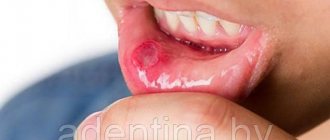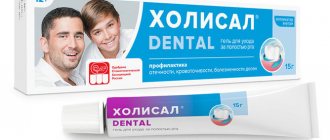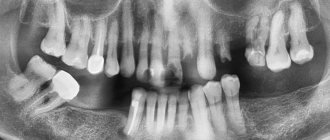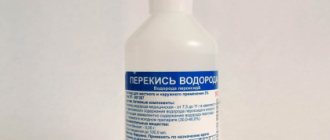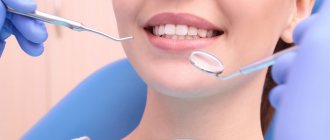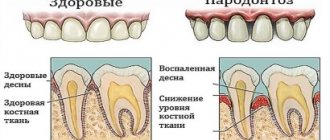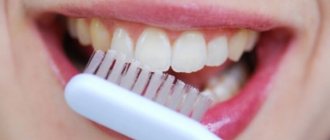Hydrogen peroxide is widely used in various fields of medicine. Several years ago, scientists announced that this substance could help fight tooth decay. Is it possible to treat caries with hydrogen peroxide, what methods are used in modern dentistry? Read about this in our article.
In this article
- Features of the use of hydrogen peroxide in dentistry
- Hydrogen peroxide in the treatment of caries
- Hydrogen peroxide in home treatment of caries
- Current methods of caries treatment
- Conclusion
Gum treatment
Each tooth is surrounded by soft tissue. They carefully protect its vulnerable spots from bacteria, the mechanical effects of food and acidity surges. The collection of these tissues around each tooth is called the gum.
- The oral cavity is a huge house in which teeth “live”.
- Each tooth has its own “apartment” - the gums.
A person feels better in a well-kept and renovated apartment. Let's make an analogy: teeth need healthy gums.
Let’s figure out what you need to be wary of and what to do if your fears become reality. Let's talk about the health of our gums.
implant surgeon, orthopedist, therapist, work experience: 12 years
The most common mistakes when dealing with symptoms of bleeding gums:
- stop brushing your teeth;
- use antiseptic rinses, gels and toothpastes (without consulting a specialist).
Such actions will only temporarily stop the symptoms, but will not prevent the recurrence of the disease.
Treatment methods for bleeding gums are aimed at stopping and stopping the development of chronic inflammation. Treatment is carried out depending on the severity of inflammation.
Dental
If you experience symptoms of bleeding gums, you should immediately contact your dentist who:
- will carry out diagnostics to identify the cause of inflammation;
- will perform ultrasonic teeth cleaning (for gingivitis) or curettage and treatment of periodontal canals (for periodontitis);
- will prescribe anti-inflammatory therapy, which lasts about 10 days. Treatment includes antiseptic rinsing with chlorhexidine solution and rinses of varying concentrations (depending on the degree of inflammation). Then a special gel is applied to the edge of the dry gum from the front of the dentition;
- will monitor the patient's condition after prescribing a course of treatment. Symptoms disappear within a few weeks and treatment can be stopped.
At home
For mild or moderate inflammation, treatment at home with folk remedies is possible.
A solution of sea salt or soda.
Salt water helps eliminate bleeding, pain, and also restores and strengthens gum tissue. To make a rinse solution, dissolve a tablespoon of salt or a teaspoon of soda in a glass of boiled water. You need to rinse your mouth three times a day for a week.
Herbal decoctions.
Such components can be found in any pharmacy. To rinse, you will need a solution of 2 tablespoons (1 filter bag) of raw material brewed in 500 ml of boiling water. The frequency of rinsing is carried out up to three times a day for a week. Decoctions of flowers (chamomile, calendula, yarrow) disinfect and relieve pain from inflammation and related diseases. A decoction of oak bark helps stop gum bleeding.
Hydrogen peroxide solution (disinfectant to stop bleeding).
This remedy is used to stop bleeding and whiten teeth. To make the solution, dilute one tablespoon of peroxide (concentration no more than 3%) with 200 ml of boiled water. You need to rinse your mouth three times a day for about five minutes for a week (the solution should not be swallowed). This product removes plaque and improves gum health.
Indications and contraindications
Hydrogen peroxide is a cheap, effective remedy for a number of diseases. It is used in therapy:
- periodontal disease;
- stomatitis;
- fungal infections of the mucous membrane and gums;
- plaque on the tongue;
- bad breath.
But keep in mind that peroxide is not a universal remedy for all diseases and it has contraindications. Rinses and compresses cannot be used for:
- advanced deep caries;
- a large number of fillings;
- advanced stages of periodontitis, accompanied by increased bleeding of the gums;
- violations of the integrity of tooth enamel.
Regular use of peroxide does a good job of brightening tooth enamel.
The substance should also not be used by children under 12 years of age. If you doubt the advisability of hydrogen peroxide therapy specifically in your case, we recommend that you first consult with your doctor.
Hydrogen peroxide in home treatment of caries
While scientists are looking for new ways to combat caries using hydrogen peroxide, fans of traditional treatment methods are offering their own options. Let us immediately note that any use of peroxide (for the prevention and treatment of caries, oral hygiene) without consulting a doctor can be dangerous to health.
On the Internet you can find dozens of folk recipes that include hydrogen peroxide. The most popular is mouthwash. It has a bactericidal effect, helps reduce pain, inflammation, and eliminate bad breath. In some cases, if indicated, such rinses may be prescribed by a dentist.
But it is important to prepare the solution correctly, otherwise there is a risk of burning the mucous membranes. A rinse solution prepared in the following proportion is considered safe. Add one teaspoon of 3% hydrogen peroxide solution to a glass of warm boiled water and mix thoroughly. Rinse your teeth with a small amount of solution for 5-7 minutes, periodically spitting out the liquid.
When rinsing, do not allow the solution to enter the esophagus and stomach, since peroxide can damage the walls of these organs. That is why you should use rinses based on hydrogen peroxide very carefully, only as prescribed by a doctor. This method should not be used by children.
Prevention
Teeth should not be allowed to be “lazy”, so chewing food should be vigorous, and the food itself should be quite tough (include plant foods in the diet). Thus, a natural massage of the gums is carried out, and their cells are renewed faster. You can also massage your gums with circular movements of your thumb, and rinse your mouth with warm water before eating.
Visits to the dentist should be regular, otherwise it is extremely difficult to save teeth in advanced forms of periodontitis.
What to do if you have periodontal disease:
- Maintain oral hygiene
- Identify the true cause of periodontal disease (general or local causes)
- Stop smoking
- Change your diet (exclude sweet foods and include plant foods.)
Solution
Medicines with antiseptic and anti-inflammatory properties can quickly relieve gum inflammation at home. In addition to them, you can also use traditional medicine.
Dental gels and rinses
Medicines for gum inflammation can be divided into 4 categories:
- Gels and solutions based on chlorhexidine. The use of these drugs for rinsing or applying to the mucous membrane can eliminate pain and prevent the development of periodontitis.
- Rinse solutions based on furatsilin, chlorophyll, medicinal plants - rotokan, stomatophyte, chlorophyllipt.
- Special dental gels enriched with anti-inflammatory components, such as propolis, will also help relieve gum inflammation.
Dental gels are more effective in the oral cavity. Unlike oil-based ointments, they are better absorbed and stay on the mucous membrane longer.
Here are the most effective gels for relieving inflammation and swelling of the gums.
Cholisal
is a two-component dental gel used for the prevention and treatment of gingivitis, stomatitis and periodontitis. Helps relieve swelling and inflammation of the gums and effectively relieves pain in the problem area. The anesthetic effect of the drug lasts up to 8 hours.
Application:
20 minutes before meals 2-3 times a day.
Metrogyl denta
– antimicrobial gel based on metronidazole and chlorhexidine. It has an anti-inflammatory and powerful antiseptic effect against a wide range of microorganisms - causative agents of gingivitis and periodontitis. Analogs of the drug Dentamet, Asepta.
Application:
2-3 times a day for 7-10 days. The gel is applied to the problem area 30 minutes before meals.
Gengigel
– a preparation based on hyaluronic acid. Restores damaged gum tissue, covers the mucous membrane with a protective film, and increases local immunity of the oral cavity. Prescribed for all diseases of periodontal tissue.
Application:
3-5 days until the symptoms of gum inflammation disappear. Used as part of complex therapy.
For the best effect, before applying the dental gel, brush your teeth, rinse your mouth with mouthwash or saline solution, wipe and dry your gums with a gauze pad.
To prevent inflammatory diseases of the oral cavity, it is recommended to use fluoride-containing toothpastes and rinses.
Traditional medicine
In combination with medications, mouth rinses can reduce pain and swelling:
- Saline or soda solution. To prepare the solution, it is recommended to add a teaspoon of sea or regular table salt (or baking soda) to a glass of warm water. Rinse your mouth with the resulting solution once every few hours.
- Herbal solutions. Decoctions of oak bark, sage, chamomile and mint are ideal for relieving gum inflammation.
How to brew the solution:
2 tablespoons of dried oak bark or other phyto-raw materials are poured into 200 ml of water and the solution is heated in a water bath for 20-30 minutes. After this, the infusion is filtered and boiled water is added to a volume of 200 ml.
How to rinse:
for a few minutes, every hour or two. After rinsing, it is recommended not to eat or drink anything for 30 minutes.
For inflammation of the gums it is also recommended:
- eat flaxseed oil, fish oil and other products containing unsaturated acids;
- use a solution of hydrogen peroxide and essential oils with an antibacterial effect.
It is better to treat gum inflammation with folk remedies after consultation with a doctor and use folk remedies as an auxiliary therapy.
Indications
Hydrogen peroxide is widely used in medicine: in surgery for the treatment of purulent wounds, for inflammatory diseases of the mucous membranes, pharyngitis, periodontal disease, for bleeding, for disinfecting instruments and deodorizing. Gargling with hydrogen peroxide makes sense when treating bacterial sore throat. But treatment with only one remedy will not be effective. It should be noted that gargling is an integral part of the complex therapy of tonsillitis.
How to treat a throat with gargling? Let's take a closer look at this issue.
| Recipe for a solution with peroxide You should not prepare the solution for future use; it is better to prepare a fresh one each time, since hydrogen peroxide erodes in the air and there will be no effect from such treatment. | To prepare the desired product, we need 1 part 3% hydrogen peroxide and 11 parts water. Water should be used boiled, cooled to a comfortable temperature of 36-37 degrees. |
| Application of the solution If you tilt your head back, the back wall of the pharynx and tonsils, and the root of the tongue will be more effectively cleansed. Remember that you should not swallow peroxide. | 1. Before the procedure, you should clear your mouth of any remaining food. 2. Take a sip, gargle for 10 seconds and spit. The steps are repeated until the solution runs out. 3. At the end of the procedure, be sure to clear the oropharynx of traces of the product with calendula tincture, chamomile tea or plain water. 4. For the next thirty minutes, you should refrain from eating and drinking. |
The duration of sessions is determined by the severity of the condition. Usually it is 4-5 days, with a frequency of 3-4 times a day. Due to oxidation, including healthy tissue, the use of peroxide can lead to increased sore throat and cough.
In addition to it, there are currently other drugs that are superior in their effectiveness. For example, Hexoral ® rinse solution. The drug is widely active against various types of bacteria and fungi of the genus Candida, and Hexoral ® also treats infections caused by Pseudomonas aeruginosa and Proteus. At a concentration of 100 mg/ml, the drug inhibits the growth of most bacterial strains. In addition, the active substance hexethidine has a weak analgesic effect. Hexoral ® solution is convenient and easy to use and has a pleasant taste. It does not need to be diluted. For adults and children over 3 years old, it is enough to gargle with 15 ml of solution 2 times a day3.
Up to contents
Indications for rinsing
Some diseases of the mucous membranes of the mouth, gums and teeth can be easily treated with these affordable remedies. And in combination they give an even faster and better effect.
Diseases of the mucous membranes and gums
Rinsing the mouth with baking soda and hydrogen peroxide is indicated for diseases such as:
periodontal disease;
- gingivitis;
- stomatitis;
- periodontitis;
- other gum diseases.
To carry out the procedure, you can use a solution of both substances or of each of them separately. The result is achieved in both the first and second cases.
Both soda and hydrogen peroxide have disinfecting properties and the ability to kill many germs and bacteria. It is these properties that allow them to quickly cope with diseases of the mucous membranes of the mouth.
Dental diseases
Tested by many generations and proven to be effective in treating teeth, as well as in teeth whitening.
Rinsing teeth with peroxide solution is used to prevent caries and bad breath. It is great for additional cleansing of the oral cavity. Rinsing with soda solution can reduce pain and inflammation in case of dental cyst formation. This rinsing is also recommended for the treatment of caries.
Caries
- Caries
- Caries is a disease accompanied by demineralization of the hard tissues of the affected teeth, their subsequent destruction and the formation of a cavity.
- To prevent caries and other dental diseases, it is recommended to brush your teeth for 2–3 minutes after each meal.
- The causes of caries development are metabolic disorders, poor diet, lack of calcium in the body, and improper dental care.
Characteristic signs of the development of caries are: a matte tint to the enamel of the affected tooth, the appearance of a white or dark spot at the site of the lesion.
In some cases, the tooth may cause pain when it is cold or hot. In the future, pain occurs in the tooth from sweet, spicy, sour foods, as well as from hypothermia. The carious cavity becomes more and more noticeable.
Other recipes with hydrogen peroxide for periodontal disease
You can add soda or lemon to the peroxide. According to reviews, treating periodontal disease at home with hydrogen peroxide will be much more effective if you combine it with other ingredients.
For example, rinsing with sea salt and peroxide will help relieve inflammation. For this, 1 tsp is enough. Dilute both in a glass of warm water, and then rinse in the usual way. Herbal infusions are also used to treat and prevent gum disease. In this case, infusions of oak bark, sage, St. John's wort and plantain are suitable. Add 5-10 drops of peroxide to the prepared broth and rinse your gums with it. It is necessary to add peroxide to the glass immediately before the procedure, when the herb has infused for the allotted time and the decoction itself becomes less hot.
With soda
Hydrogen peroxide and soda are one of the popular methods for treating periodontal disease at home. To prepare the solution you will need dry peroxide, and it is better to use sea salt. If it is coarsely ground, make sure that it is completely dissolved in the water. Under no circumstances should the prepared solution be swallowed.
Ingredients:
- Dry peroxide - 2 tablets.
- Salt - 1 tsp.
- Water - 200 ml.
How to prepare : Mix all ingredients.
How to use : Rinse your mouth with the resulting solution 3-4 times a day. The duration of the procedure is 5 minutes. The course of therapy is 1 month.
Result : Washes away pathogenic microorganisms from the surface of the gums, stops bleeding, promotes the regeneration of soft tissues.
With lemon
At home, periodontal disease can be treated with hydrogen peroxide, baking soda and lemon. This product can replace toothpaste. You should not do this regularly - for prevention purposes, one procedure every 7-10 days is enough.
Ingredients:
- Baking soda - 3 g.
- Lemon juice - 10 drops.
- 3% hydrogen peroxide - 20 drops.
How to prepare: Add fresh citrus juice to the soda and stir thoroughly. Then add peroxide.
How to use : Brush your teeth with the resulting mixture; no need to rinse your mouth. After the procedure, you should not eat or drink for at least 15 minutes.
Result : Heals gums, promotes periodontal regeneration.
How does peroxide affect teeth?
Peroxide is a very strong oxidizing agent, which, on the one hand, effectively whitens teeth, and on the other, increases their sensitivity. Therefore, those who already complain about the sensitivity of their teeth should avoid this method.
During the whitening process, peroxide penetrates the tooth enamel and dentin of the teeth, and begins to lighten them. Moreover, a good result is visible after a couple of weeks of use.
Many dentists question the advisability of using peroxide for whitening, but many ordinary citizens, due to the effectiveness and low cost of this method, prefer to whiten their teeth with peroxide.
Teeth whitening with hydrogen peroxide at home: basic methods
- There are several basic ways to use peroxide for DIY whitening.
- Peroxide solution with water. Prepare the solution: dilute 3% peroxide with ordinary purified water in a 1:1 ratio. Brush your teeth in the usual way (it is advisable to use fluoride paste), then rinse your mouth with the prepared solution, then thoroughly with plain water. This remedy should be used twice a day. After a week, you need to take a break for at least a couple of weeks, then the procedure can be started again.
- A mixture of peroxide and toothpaste. Mix a teaspoon of toothpaste and a teaspoon of hydrogen peroxide (3%). Brush your teeth with the mixture twice a day, take a break after seven days. You need to understand that even if this method does not show such an impressive result as the previous one, it is more gentle and gentle on tooth enamel.
- Peroxide rinse. Take 30 ml (about two tablespoons) of undiluted 3% peroxide and rinse your mouth for sixty seconds. Foam appears - don’t be alarmed, this is how it should be. After this, you need to spit out the solution, rinse your mouth thoroughly with water and be sure to brush your teeth thoroughly. Under no circumstances should you swallow the solution!
- A mixture of peroxide and tooth powder. You need to take in equal proportions, for example, a teaspoon, peroxide and tooth powder. Mix and use instead of toothpaste a couple of times a day. Then rinse your mouth thoroughly.
- A solution with the addition of soda and salt. Prepare a solution using 1 part peroxide (3%) and two parts water, add soda and salt. After this, rinse your mouth with the resulting solution and brush your teeth using a soft brush.
- A mixture of baking soda and hydrogen peroxide. Prepare a paste of 15 ml of baking soda and 10 ml of hydrogen peroxide. To give the resulting solution a pleasant taste and fresh aroma, you can add a drop of mint extract or a little toothpaste to it. Apply the resulting paste onto your teeth using circular movements and wait a couple of minutes. Rinse thoroughly with water and brush with toothpaste.
- Pure peroxide. Used to remove plaque from a specific problem area. To do this, dip a cotton swab in peroxide and apply it to an individual tooth, rinse and use toothpaste.
Advice one. Whiten your teeth with hydrogen peroxide.
Do not under any circumstances try to restore the whiteness of your smile using this aggressive chemical composition! Yes, statements that compounds based on hydrogen peroxide are actively used in dentistry are indeed justified. But in the doctor's office you will receive a carefully selected dosage of a special mixture, where peroxide does not occupy a primary place. At best, when using peroxide at home, you will not get any results at all. In the worst case, you will burn your oral cavity, damage the enamel, and for a long time you will get rid of the consequences of your own indiscretion.
